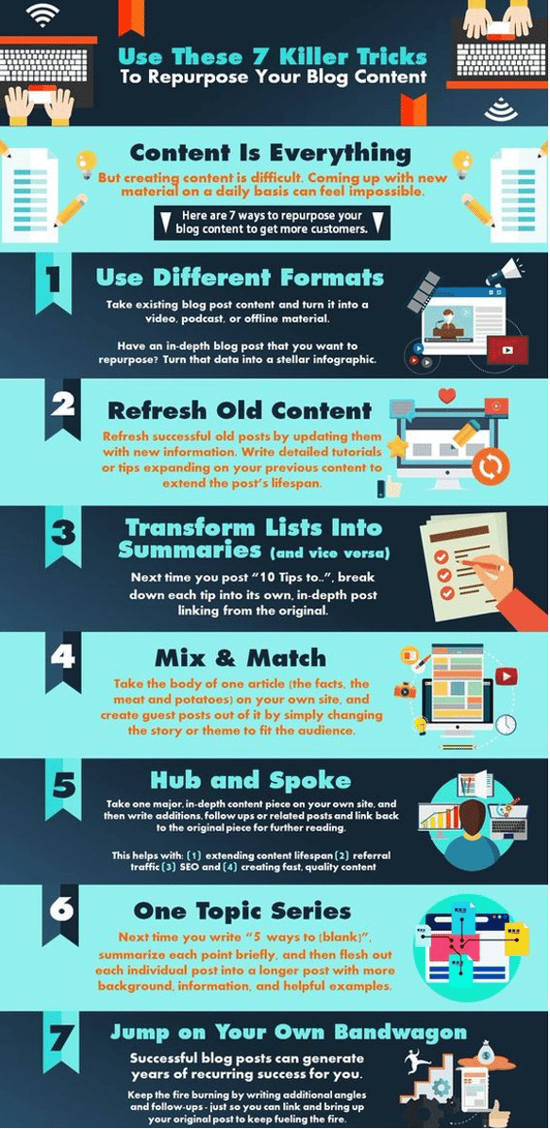7 Ways to Extend Your Marketing Content’s Reach & Return
Recently, we shared with you some of the challenges content professionals—strategists, writers, editors and others—face in developing the marketing content needed. Whether it was writers and strategists struggling to develop relevant ideas or project managers working to squeeze the most results out of the available resources, one possible solution to both sets of challenges lies in repurposing content.
You’ve heard the expression “work smarter, not harder,” I’m sure. That is what repurposing content achieves. Or to fall back on an even more hackneyed cliché, you can “kill two birds with one stone.” Or maybe even more than two.
When you find that relevant topic that will reach your target audience and invest time into developing the data and messaging that resonates and brings customers to your door, don’t stop after creating a single piece of content. Continue mining the same content for additional opportunities, as described in this infographic, which was shared on Twitter by Brian Hazel.

Before we review the list of tips offered in the infographic, I want to point out that while you can always go back into existing content and find new ways to use it, the most effective method of maximizing the return on your content ideas and development is to plan from the beginning to use it in multiple ways. I’ve outlined before how to start from a basic abstract and develop it into multiple elements for a single campaign, including contributed bylined articles, marketing reports and blog posts. And those are still just the beginning.
Now, on to the suggestions in the infographic:
1. Use different formats.
In other words, create it once, publish it multiple ways. We do this routinely for both our own content and our clients’ content. You can see examples in the complete campaigns we have created for clients such as Avanti Systems and Intrado. Ebooks or reports are rewritten as blog posts, packaged as contributed articles or even worked into webinars. Because your audience will include individuals with a variety of content format preferences, offering video as well as written posts or quick-read infographics to go with detailed data extends your reach.
2. Refresh old content.
Even evergreen blog posts that are still attracting attention and landing high in search engine results could use an update every now and then. We’ve taken time in the last year to update our most popular posts with the latest data and new imagery, such as adding TikTok to our perennially popular guide to social media, since it hadn’t yet been introduced when that post first published. It just makes sense to ensure that content that is still gaining attention reflects current data, recommendations and branding.
3. Transform lists into summaries (and vice versa).
Our marketing lessons series published for the 15th anniversary of JONES is a great example of combining a concise list with more in-depth individual articles. You can see the overview of our 15 marketing lessons in this infographic and post, while each of those lessons is examined in detail with additional examples in individual blog posts.
4. Mix and match.
This fits in with the idea from #1 of using different formats. Changing up content slightly for different channels provides more mileage from the same article. When we publish content as LinkedIn articles, it may be very similar to a blog post, but with a slight shift in perspective based on the more refined audience. If you have multiple business blogs, as our partner HubSpot does, you could write a post for one blog (for example, HubSpot’s marketing blog), but then use the same concept with a slightly different focus to appeal more to the readers of the sales blog.
5. Hub and spoke.
Linking to related posts or website pages is a great way to extend website visitors’ time on your site, which is an important signal to search engines that readers find your content valuable. Using the example, again, of our Complete Social Media Guide blog post, we mix up our blog post strategy with a combination of bite-sized “quick tips” and longer in-depth material. When we publish a “quick tip” like this one about social media, we always link to the in-depth guide to providers readers with more information if they want it.
6. One topic series.
This is another way of looking at the list/summary idea above or of creating a common theme to carry through your blog strategy. For example, we have created a series of blog posts explaining how to use the resources included in our Inbound Learning Library. You can find “How to Use Our Lead Nurturing Workflow Template,” “How to Use Our Campaign Planning Calendar” or “How to Use Our Website Audit Template.”
7. Jump on your own bandwagon.
While the infographic primarily mentions extending the life of blog posts by linking to them from newer posts about a similar topic (which we do all the time to help our readers find more relevant information), I think “jumping on your own bandwagon” also speaks to the need to amplify your content across other channels. The perfect example: social media. Using social media immediately after content is published (and again weeks, months or even years later) can increase the visibility of your blog posts and other website content, whether you are sticking with strictly organic content or promoting posts and using paid advertising on social media. The key is to keep it relevant and offer value.
What other tricks do you have for extending the life, reach and ROI of your content creation efforts? As I said earlier, the best method is to plan your repurposing from the beginning. It is simple with our Campaign Planning Calendar Template, available here for free download.
Having a full-service team to help you see and maximize those opportunities can be a huge advantage. Talk with us about how to develop a strategy that carries the same message through multiple channels and formats—video, podcasts, blog posts, infographics, contributed articles, social media and more. You can schedule a time in my calendar here for a no-obligation consultation.
-1.png?width=1652&height=294&name=Jones(RGB)-1.png)









.jpg?width=352&name=Get%20More%20Mileage%20From%20Your%20Marketing%20Content%20(infographic).jpg)


